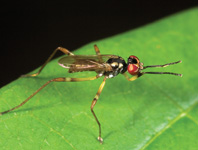Abstract
The phallus in Tettigoniidae (katydids) is a structure informative relative to the systematics of the group. Despite this, it is often not considered in descriptions of taxa. The lack of adequate descriptions of phalli is not only a gap for systematic and morphological studies, but postpones works on the evolution of copula. Here we study the exoskeletal morphology of the phallus in katydids, its components, and revised the terminology for them. We carried out dissections for morphological comparisons, and complement the observational information with published data. We stained phalli of katydids with chlorazol black, to better contrast membranous versus sclerotized components. We demonstrate that phallic components vary at specific, generic and suprageneric levels, and that internal and external components vary in number, shape, size and position. Currently there is little comparative data to support hypotheses on the evolution of this structure, but possibly the possession of a titillator is an ancestral condition. We identify additional sclerotized components, the sclerites of the ventral fold of the dorsal lobe, which can modify the shape and function of the titillator, being also important for understanding the evolution of the phallus. Potential functional relationships based on hypothetical morphological correlations between the shape of titillator and cerci are proposed, categorized in three main groups: (i) phallus devoid of titillator and cerci simple, (ii) titillator with bifurcated or paired sclerites, and cerci adapted for grasping, and (iii) titillator with single process and/or sclerite and cerci simple, sometimes with a pointed tip. Two explanations for these hypothetical morphological correlations and morphological variation are proposed: first, species with similar structures at the postabdomen would share similar copulatory behaviour, and second, more than one selective pressure would have acted over the structures of the postabdomen.

